So Long Ruth Porter Mall
Tearing down a mall? What stores did it have? No, not that kind of mall. A pedestrian mall.
Ruth Porter Park (officially named Ruth Porter Mall), is a linear park spanning nine blocks north from Delmar Blvd. to Etzel Ave., and one block west from Debaliviere to Goodfellow Ave. (source)
Most pedestrian malls were created by closing off a roadway but Ruth Porter Mall was created by razing buildings along a linear path. A 1971 aerial on historicaerials.com shows the clearing of buildings present in a 1958 aerial. By the time I first walked it in the 1990s it was looking very tired. View in Google Maps here.
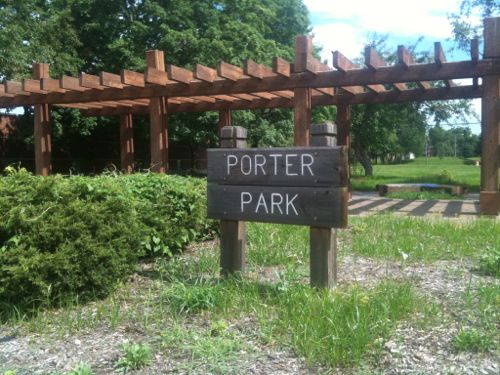
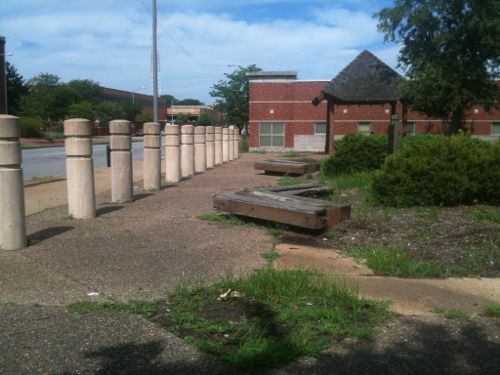
Who was Ruth Porter anyway? She was an African-American born in 1915 who died just 52 years later in 1967:
Ruth Porter was a founder and first executive secretary of the Greater St. Louis Committee for Freedom of Residence, a group organized in 1961 to break down housing restrictions and integrate housing in St. Louis. In 1958, she won an award from the National Conference for Christians and Jews for promoting racial understanding. She was named outstanding woman of the year in 1965 by the NAACP. Her tireless efforts to secure fair housing eventually led to the landmark U.S. Supreme Court decision in the Jones vs. Mayer case, which was won by residents she helped to support.
At one time Porter was also director of the Kinloch YMCA and a leader in the West End Community Conference. The Ruth Porter Mall at Delmar Boulevard and DeBaliviere Avenue is named in her honor. (Source)
The Supreme Court decision came a year after her passing.
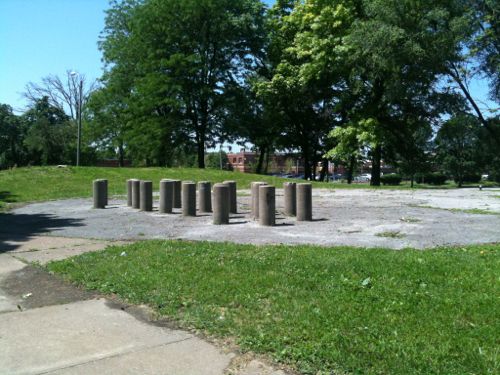
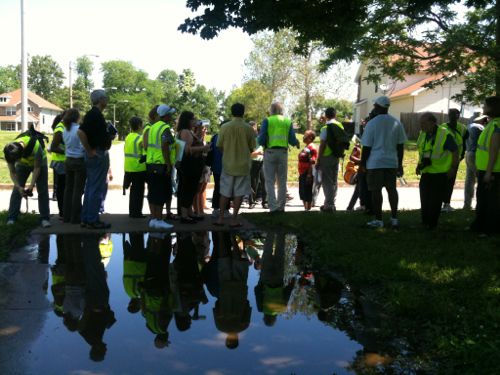
So what will become of the space? It’ll be incorporated into a larger trail network:
St. Vincent Greenway will extend for more than seven miles from NorthPark, near I-70 and Hanley Road, to Forest Park. The greenway route includes the completed sections through University of Missouri-St. Louis campus and the adjoining St. Vincent (County) Park.
The primary trail will continue to the Rock Road MetroLink station area, the MET Center in Wellston, and the West End and Skinker-DeBaliviere neighborhoods. The greenway will follow Engelholm Creek as much as possible.
The remainder of the primary greenway trail from the North Hanley MetroLink station to Forest Park is being designed.
The next segment slated for construction lies within the City of St. Louis. Construction through Porter Park (Ruth Porter Mall), and along Etzel Avenue from the park west to Skinker, will begin in October. Finishing touches will be applied in the spring.
At Forest Park, St. Vincent Greenway eventually will connect to other greenways, such as Centennial, Chouteau, and River des Peres. In the NorthPark business development, the greenway will meet the Maline Creek Greenway now being planned. (Great Rivers Greenway)
That’s a nice connection.
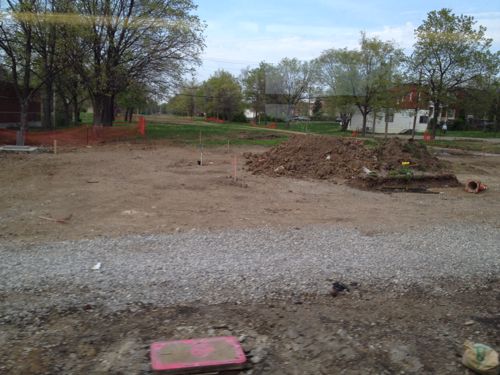
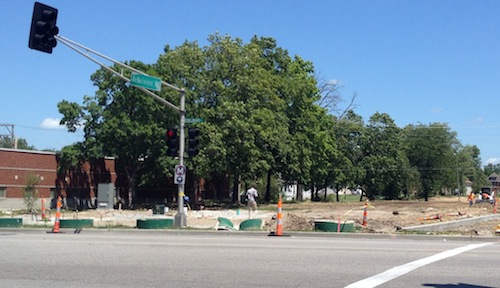
More from Great Rivers Greenway’s website:
This extension of the St. Vincent Greenway will change the usage of public right-of-way along Etzel Avenue from Skinker Boulevard eastward to Porter Park, allowing a physical separation of the greenway route from vehicles. The existing sidewalk in Porter Park will be re-surfaced as a trail. Both segments will contain many delightful upgrades and surprises.
When the Loop Trolley is constructed, the greenway will continue within the eastern half of the right-of-way of DeBaliviere Avenue south to Forest Park. (source)
The Ruth Porter Mall wasn’t accesible at all. It was built pre-ADA and it was never retrofitted with wheelchair ramps. I’m glad to see it change and become part of something bigger but I hope Ruth Porter is somehow remembered.
— Steve Patterson
Interesting, on several levels. Obviously, the Porter name deserves to be retained, and it’s good to see ongoing efforts to complete a viable trail system. I’m not sure if you had any observations about demolishing blocks of buildings to create the original corridor. But what I found to be disturbing, but not surprising, was the lack of maintenance that got the park to the dilapidated state that you first saw it. Why do we, as a community, continue to make random investments, be they linear parks, neighborhood gateways, public art, street trees, banners or sidewalks, and then, essentially, just walk away and let them crumble?! I get it, maintenance is boring, it’s always there, and it doesn’t create photo op’s or press releases. It doesn’t look great on campaign materials and you really can’t associate a locally-important name with it. But maintenance is what government is supposed to do, it’s what we pay taxes for. It’s good to see the accessibility improvements that are happening here, but what about all our other parks? What about the many, many intersections around town that need ramps? I’m just afraid that we’re just repeating the cycle here, and that in another 40 or 50 years, another generation will be patting themselves on their backs about another “worthwhile” project . . . .
If a parking lot is designed and constructed in the City of St. Louis and located within a certain geographic area (mostly downtown), certain stringent landscaping requirements are placed on the project. So in the end and if constructed per city standards, just prior to the lot’s opening, everything is picture perfect: the lot is neatly striped, all the ADA signs are installed, and any sodded area, all the trees and bushes are in place. Everything probably looks as good as it possibly can, given the fact that it’s a (necessary) parking lot. It would appear, though, that there are few if any City enforcements in place for maintenance. And within a few years after initial occupancy, the trees and bushes probably go untrimmed, grass and weeds begin to grow up in odd and unwanted places within the planting areas, bushes die because either irrigation wasn’t initially provided, or the contractor failed to remove all the concrete slobbers and gravel in the planting areas, left behind from the curbs and pavement placement, creating a hostile environment for plant roots…… and the place begins to look worse than it would have had the asphalt initially extended to the street curbs and without all the fanfare. (Personal observation/personal opinion) Let’s hope this doesn’t happen with the St. Vincent Greenway.
While I get the “City should maintain the parks they build” mantra, in this sad days of the Republic and the insesent crying for lower and lower taxes, priorities need to be made. Taxpayers for the most are ignorant to think that taxes can continually go lower and yet everything miraculously continues to be maintained, improved, expanded. But I digress….
Maintainance of parks falls way down that list as do other forms of maintainance. Is it right? I would say no…preventative means exactly that: prevent. But it isn’t always the City either. Why weren’t neighborhood groups helping maintain it as well? All across the region there are private, non-official groups of citizens that realize whether it is the City, Webster, or Manchester, their City can’t do it all and they adopt parts of things to help maintain. But all that is moot now.
I have volunteered with Greenways when they were just starting out. I continue to be impressed how they manage to expand, expand, and expand. Spending those tax dollars for the good of all, not just the City, Webster, and Manchester. Many taxing entities could learn a thing or two from them and how they operate.
The park is in good hands.
JZ71’s point was essentially that if you can’t afford to maintain it, maybe you should build it.
“shouldn’t”
Agree. We seem willing to spend more than $40 million in bonded indebtedness to build two major new recreation centers, yet we seem to expect “volunteers” to keep up our neighborhood parks.
I agree, governmental budgets, especially in times of stagnant or declining revenues, require hard choices. My point is that maintenance invariably seems to be one of the first things to get cut, much like contributions to pensions and vehicle purchases, viewed as things that can be “deferred” to future budget cycles. Unfortunately, “kicking the can down the road”, more times than not, can only go so far, and even when things do improve, the amount of deferred maintenance always seems to be much bigger than anyone wants to include in the budget!
I think this project is really exciting. It represents one of the first really useful bike paths I can think of. The riverside trail is beautiful, but isn’t helpful for commuting, while the River des Peres trail is neither useful nor attractive. However, lots of people actually want to go to U City, or up to UMSL, and many go back and forth. I used to bike from my old apartment in U City to UMSL every day, and I usually feared for my life due to the complete lack of bike lanes or paths the whole way there. If I still lived in U City, this will allow one to get almost all of the way to UMSL with hardly having to encounter a car. I think people will actually use this trail somewhat extensively compared to others built so far.